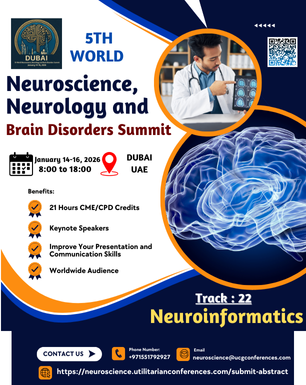



Sub Topics: Molecular and Cellular Neuroscience, Cognitive Neuroscience,...

Sub Tracks Clinical Neurology, Neurodegenerative...

Neuroinformatics
Cerebrovascular disorders refer to conditions that affect
the blood vessels of the brain, resulting in a disruption of the blood flow to
the brain. These conditions can lead to various neurological deficits,
including cognitive impairments, physical disabilities, and sometimes death.
The brain requires a constant supply of oxygen and nutrients from blood
vessels, so any blockage, rupture, or narrowing of these vessels can lead to
significant damage.
A stroke occurs when
blood flow to a part of the brain is either blocked (ischemic stroke) or
interrupted due to bleeding (hemorrhagic stroke), causing brain cells to die or
become damaged.Often called a "mini-stroke," a TIA involves a
temporary reduction in blood flow to the brain, typically lasting less than 24
hours, with no lasting brain damage.A brain aneurysm is a bulging or ballooning
of a blood vessel in the brain. If it bursts, it can cause a hemorrhagic
stroke.AVMs are abnormal tangles of blood vessels connecting arteries and veins
in the brain. These abnormal connections disrupt the flow of blood and can lead
to rupture and bleeding.
Hypertension
(High Blood Pressure): The leading risk factor for both
ischemic and hemorrhagic stroke.
Atherosclerosis:
Hardening and narrowing of arteries due to the accumulation of fatty deposits.
Smoking:
Increases the risk of blood clot formation and atherosclerosis.
Diabetes:
Increases the likelihood of developing atherosclerosis and stroke.
Heart
Disease: Conditions like atrial fibrillation can lead to clot
formation, which may travel to the brain, causing a stroke.
Obesity
and Physical Inactivity: These contribute to high blood
pressure, diabetes, and heart disease, all of which increase the risk of
cerebrovascular disorders.
Age and
Gender: Older individuals are at a higher risk, with men
generally being more affected, although the risk for women increases after
menopause.
Family
History: A family history of stroke or heart disease increases
an individual’s risk.
Alcohol
and Drug Use: Excessive alcohol intake or illicit drug use
(e.g., cocaine) can increase the risk of stroke.